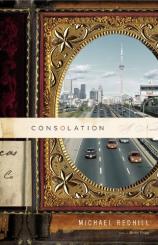Consolation
Review
Consolation
As most people walk the streets of the typical North American city,
they give little thought to the sometimes sedimentary way in which
their modern urban environment has risen out of the deposits of
previous generations in a ceaseless cycle of building, destruction
and rebuilding. In his latest novel, set in his hometown of
Toronto, Michael Redhill makes that subject the springboard for a
haunting exploration of a historical mystery that insinuates its
way into the lives of a group of contemporary characters.
David Hollis teaches "forensic geology," a field he describes as
"combining landforms with sleuthing." In his early 60s, he is
diagnosed with Lou Gehrig's disease and knows he is faced with an
inevitable decline into disability and eventual painful death. His
final professional work is a monograph in which he argues that the
wreckage of a mid-19th century steamer, the Commodore
Walker, containing a priceless photographic record of the
Toronto of that era, lies buried in ground about to be covered over
with concrete for a new hockey arena. Dismayed by the derision that
greets his work, and his steadily worsening physical condition, he
commits suicide by falling from the deck of a ferry on its way from
the city to the Toronto Islands in Lake Ontario.
A few months after his death, David's widow, Marianne, ensconces
herself on the 33rd floor of a Toronto hotel overlooking the
construction site. There, she waits patiently for physical evidence
to corroborate her late husband's theory, motivated by his belief
that "There is a vast part of this city with mouths buried in
it…But we stop them up with concrete and build over them, and
whatever it is they wanted to say gets whispered down empty alleys
and turns into wind. People need to be given a reason to listen."
At first, only John Lewis, her daughter Bridget's fiancé, is
aware of the purpose of her hotel vigil. John played a role in
David's suicide that he refuses to acknowledge to himself or reveal
to the women of the Hollis family. Gradually, he becomes obsessed
with Marianne's quest and is determined to do what he can to halt
the construction before the past is entombed forever.
Interwoven with the modern narrative is the story of J.G. Hallam,
set in Toronto between 1855 and 1857. Hallam has come to the rough,
young city to establish an apothecary business like the one his
family has operated successfully in England. Soon, he finds himself
crushed by ruthless competitors, and he develops an unusual
friendship with two other down-on-their-luck Torontonians: Sam
Ennis, an Irish photographer of somewhat unsavory personal habits
to whom Hallam provides the silver nitrate used in preparing glass
photographic plates; and Claudia Rowe, one of Ennis's models and
the widow of a telegraph worker whose disappearance has prevented
her from collecting on a substantial life insurance policy and who
now is consigned to a life of poverty.
When Hallam finally abandons his apothecary business, he forms a
photography partnership with Ennis and Rowe. In time, they produce
a nearly complete photographic record of the city of Toronto in
1856. On the way home from England, where the photographs are used
to support Toronto's bid to become the capital of the Province of
Canada, the Commodore Walker runs aground in the city's
harbor, and this irreplaceable photographic evidence is lost.
In lyrical prose, Redhill returns time and again to the theme of
destruction and rebirth that is reflected in the cycles of city
life. J.G. Hallam, in 1856, "could not imagine a future when the
streets would not be pockmarked in regular intervals by butts of
brick and piles of wood, forged and cast nails being ground
underfoot for future generations to chance on." One hundred and
forty years later, John Lewis reflects that "Boats and dead pets
and lost shoes became layers of earth; wooden carts, yellow brick
and stamped tin ceiling tiles, cherished knickknacks and empty
liniment bottles and gutta-percha photograph cases and ceramic
dolls with their painted eyes rubbed almost clean --- all things
cooperated with extinction; only people held them tight."
We live in a world obsessed with the idea of novelty, the quest for
the latest "new, new thing." Pausing for a few hours to savor
CONSOLATION may be a worthwhile antidote for that neurosis.
Although it undoubtedly will have special resonance for readers
living in Toronto or those familiar with the city, this compelling
novel deserves a wide audience.
Reviewed by Harvey Freedenberg ([email protected]) on December 28, 2010
Consolation
- Publication Date: January 10, 2007
- Genres: Fiction
- Hardcover: 352 pages
- Publisher: Little, Brown and Company
- ISBN-10: 0316734985
- ISBN-13: 9780316734981










